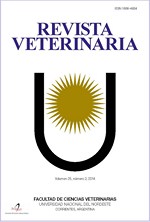Effect of stocking density and shed area on welfare indicators in broiler chickens
DOI:
https://doi.org/10.30972/vet.3326188Keywords:
Animal welfare, Environmental conditions, Commercial productionAbstract
The aim of this work was to evaluate the effect of decreasing stocking density and shed area on footpad dermatitis, hock burn, and ventral feathers cleanliness of broilers reared in winter. The work was carried out on a commercial farm in the northeast of the Santa Fe province, Argentina. 54,000 broilers were housed in sex-mixed batches, in two darkened sheds, divided into three zones: Panels, Intermediate and Extractors. Two stocking densities were evaluated: 14 and 12 chickens/m2, standard and reduced, respectively. At 41 days feet and hock lesions and cleanliness of ventral feathers was assessed in 120 chickens per area. Significant differences were registered for footpad lesions in Extractors (p = 0.0006), Intermediate (p = 0.0002) and Panels (p <0.0001) zones, with predominance of lesions 1 and 2 in Intermediate and Panels zones with standard density. Non-significant differences were observed for hock lesions in Extractors (p = 0.111) a response not seen in Intermediate (p = 0.024) and Panels (p <0.0001) zones, with more type 2 lesions in both zones under standard density. Feather cleanliness showed significant differences in Extractors (p = 0.014) Intermediate (p = 0.01) and Panels (p <0.0001), with a higher proportion of type 3 plumage dirt with standard density. Welfare indicators behaviour showed the favourable change achieved by reducing stocking density in broilers production.Downloads
References
Bailie CL, Ijichi C, O’Connell NE. 2018. Effects of stocking density and string provision on welfare-related measures in commercial broiler chickens in windowed houses. Poult Sci 97 (5): 1503-1510. https://doi.org/10.3382/ps/pey026.
Buijs S, Keeling L, Rettenbacher S, Van Poucke E, Tuyttens FAM. 2009. Stocking density effects on broiler welfare: Identifying sensitive ranges for different indicators. Poult Sci 88 (8): 1536–1543. https://doi.org/10.3382/ps.2009-00007.
Dawkins MS, Donnelly CA, Jones TA. 2004. Chicken welfare is influenced more by housing conditions than by stocking density. Nature 427 (6972): 342-344.
Estevez I. 2007. Density allowances for broilers: where to set the limits? Poult Sci 86 (6): 1265-1272. https://doi.org/10.1038/nature02226.
European Commission. 2007. Council Directive 2007/43/EC of 28 June 2007 laying down minimum rules for the protection of chickens kept for meat production. In: Official Journal, L 182, 12/07/2007, 19-28.
Farhadi D, Hosseini SM, Dezfuli BT. 2016. Effect of house type on growth performance, litter quality and incidence of foot lesions in broiler
chickens reared in varying stocking density. J Biosci Bioeng Biotechnol 5 (1).
Gholami M. 2020. Effects of stocking density and environmental conditions on performance, immunity, carcase characteristics, blood constitutes, and economical parameters of Cobb 500 strain broiler chickens. Ital J Anim Sci 19 (1): 524-535. https://doi.org/10.1080/1828051X.2020.1757522.
Hashimoto S, Yamazaki K, Obi T, Takase K. 2011. Footpad dermatitis in broiler chickens in Japan. J Vet Med Sci 73 (3): 293-297. https://doi.org/10.1292/jvms.10-0329.
Huth JC, Archer GS. 2015. Comparison of two LED light bulbs to a dimmable CFL and their effects on broiler chicken growth, stress, and
fear. Poult Sci 94 (9): 2027-2036. https://doi.org/10.3382/ps/pev215.
Ibrahim RR, Abdel-Azeem NM, Mostafa AS, Emeash HH. 2017. Studies on some welfare aspects of broilers reared under different stocking densities. JAVS 2 (1): 23-34.https://doi.org/10.21608/javs.2017.62137.
Ibrahim SS. 2017. Effect of different stocking densities on the broiler production farms profitability. Alex J Vet Sci 52 (1). https://doi.org/10.5455/ajvs.253215.
Jacob FG. 2016. Risk of incidence of hock burn and pododermatitis in broilers reared under commercial conditions. Braz J Poult Sci 18: 357-362. https: //doi.org /10.1590/1806-9061-2015-0183.
Kjaer JB. 2006. Foot pad dermatitis and hock burn in broiler chickens and degree of inheritance. Poult Sci 85 (8): 1342-1348. https://doi.org/10.1093/ps/85.8.1342.
McWard GW, Taylor DR. 2000. Acidified clay litter amendment. J Appl Poult Res 9 (4): 518-529. https://doi.org/10.1093/japr/9.4.518.
Moreki JC, Magapatona S, Manyeula F. 2020. Effect of stocking density on performance of broiler chickens. Int Journal of Agric and Rural Dev. http://researchhub.buan.ac.bw/handle/123456789/40#.
Musilová A, Lichovníková M, Hampel D, Przywarová A. 2013. The effect of the season on incidence of footpad dermatitis and its effect on broilers performance. Acta Univ. Agric. Silvic. Mendelianae Brun 61: 1793-1798. http://dx.doi.org/10.11118/actaun201361061793.
Petek M, Üstüner H, Yeşilbağ D. 2014. Effects of stocking density and litter type on litter quality and growth performance of broiler chicken. Kafkas Univ Vet Fak Derg 20 (5): 743-748. https://doi.org/10.9775/kvfd.2014.11016.
Shepherd EM, Fairchild BD. 2010. Footpad dermatitis in poultry. Poult Sci 89 (10): 2043-2051. https://doi.org/10.3382/ps.2010-00770.
Škrbić Z, Pavlovski Z, Lukić M. 2009. Stocking density: factor of production performance, quality and broiler welfare. Biotechnol Anim Husb 25 (5-6-1): 359-372. https://doi.org/10.2298/BAH0906359S.
Son JH. 2013. The effect of stocking density on the behaviour and welfare indexes of broiler chickens. J Agric Sci Technol 3 (4A): 307.
Thomas DG. 2004. Influence of stocking density on the performance, carcass characteristics and selected welfare indicators of broiler chickens. N Z Vet J 52 (2): 76-81. https://doi.org/10.1080/00480169.2004.36408.
Downloads
Published
How to Cite
Issue
Section
License
Revista Veterinaria (Rev. Vet.) maintains a commitment to the policies of Open Access to scientific information, as it considers that both scientific publications as well as research investigations funded by public resources should circulate freely without restrictions. Revista Veterinaria (Rev. Vet.) ratifies the Open Access model in which scientific publications are made freely available at no cost online.








